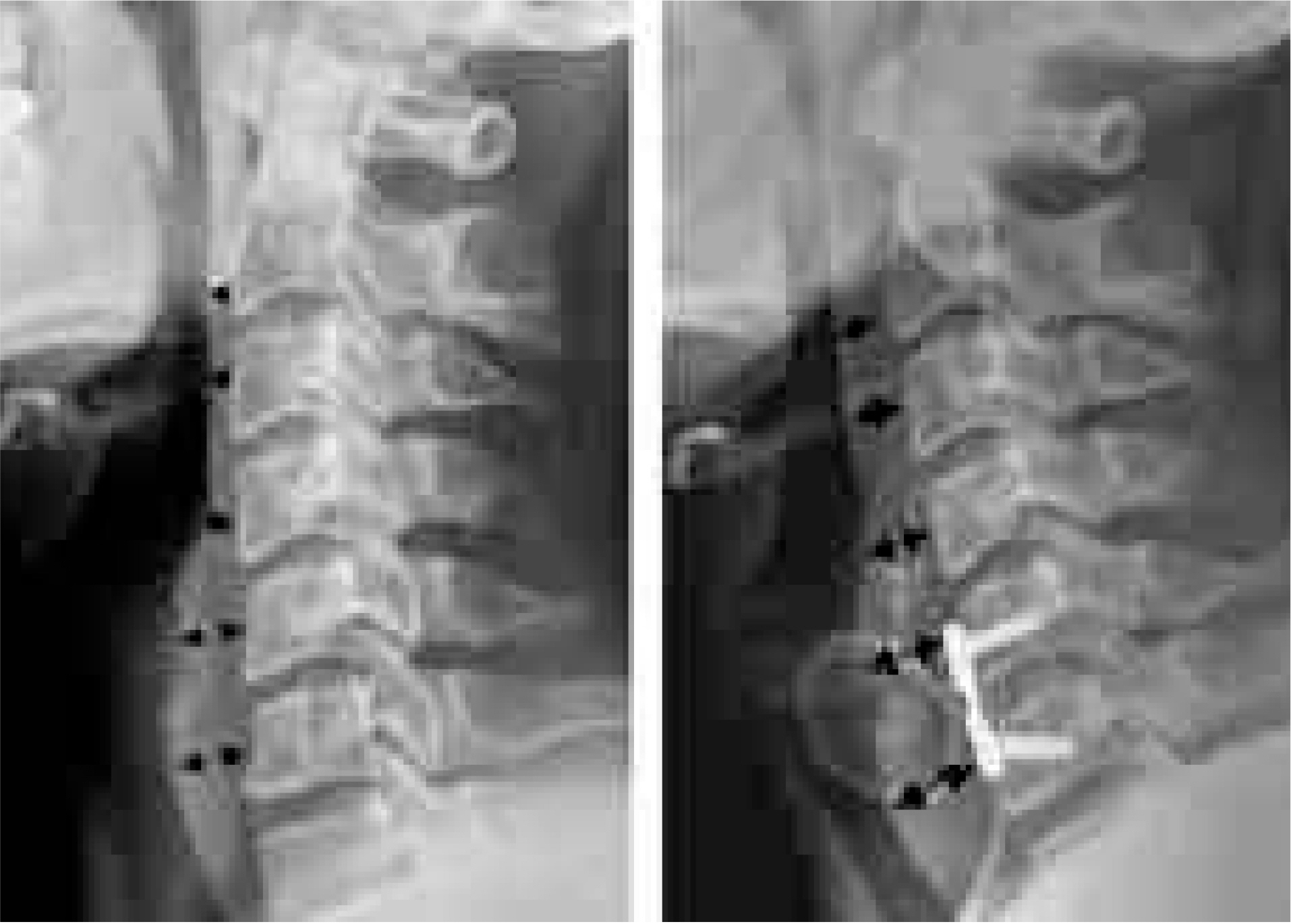J Korean Soc Spine Surg.
2004 Sep;11(3):168-173. 10.4184/jkss.2004.11.3.168.
Prevertebral Soft Tissue Swelling After Anterior Cervical Discectomy and Fusion
- Affiliations
-
- 1Department of Orthopaedic Surgery College of Medicine, Kyung Hee University Seoul, Korea. sks111@khmc.or.kr
- KMID: 1839988
- DOI: http://doi.org/10.4184/jkss.2004.11.3.168
Abstract
- STUDY DESIGN: Prospective study of 87 patients
OBJECTIVES
To identify the natural course of the prevertebral soft tissue swelling after a one- or two-level anterior cervical discectomy and fusion (ACDF) and to help prevent potentially lethal airway complications after an ACDF. SUMMARY OF LITERATURE REVIEW: Airway complication after anterior cervical surgery is rare but potentially lethal.
MATERIALS AND METHODS
Eighty-seven patients who underwent a one- or two-level ACDF with a plate and screws were examined. Cervical spine lateral radiography was taken preoperatively, on the immediate postoperative day, 1st, 2nd, 3rd, 4th and 5th day after surgery. Prevertebral soft tissue was measured from C2 to C6 on the cervical spine lateral radiography.
RESULTS
Prevertebral soft tissue swelling occurred postoperatively and increased markedly on the second day after surgery. The peak prevertebral soft tissue swelling was observed on the second and third day after surgery. The prevertebral soft tissue swelling was decreased gradually from the 4th day after surgery. Prominent swelling of the prevertebral soft tissue was found at the 2nd, 3rd and 4th cervical spine. There were no significant differences in the prevertebral soft tissue swelling between the one-level and two-level ACDF group. Only one patient required reintubation (1.1%)
CONCLUSIONS
The peak prevertebral soft tissue swelling was observed on the second and third day after surgery. Therefore, maintaining intubation for 3 or 4 days after surgery would be helpful in high-risk patients.
Figure
Reference
-
1). Emery SE, Smith MD, Bohlman HH. Upp er-ai rw ay obstruction after multilevel cervical corpectomy for myelopathy. J Bone Joint Surg. 1991; 73-A:544–551.2). Fujiwara H, Nakayama H, Takahashi H, Shimizu M, Hanaoka K. Postoperative respiratory disturbance after anterior cervical fusion. Masui. 1998; 47(4):475–478.3). Epstein NE, Hollingsworth R, Nardi D, Singer J. Can airway complications following multilevel anterior cervical surgery be avoided? J Neurosurg. 2001; 94(2s):185–188.
Article4). Sagi HC, Beutler W, Carroll E, Connolly PJ. Airway complications associated with surgery on the anterior cervical spine. Spine. 2002; 27(9):949–953.
Article5). DeBehnke DJ, Havel CJ. Utility of prevertebral soft tissue measurements in identifying patients with cervical fracture. Ann Emerg Med. 1994; 24(6):1119–1124.6). Uppal GS, Akmakjian J. Outpatient cervical spine fusions. Abstract book of 14th annaual meeting of North American Spine Society. 1999; 158.
- Full Text Links
- Actions
-
Cited
- CITED
-
- Close
- Share
- Similar articles
-
- Airway Obstruction Caused by Prevertebral Soft Tissue Swelling after Anterior Cervical Discectomy and Fusion: A Case Report
- Prevertebral Soft Tissue Swelling after Anterior Cervical Discectomy and Fusion: Comparison between Plate Fixation and Cage Insertion
- Efficacy of Postoperative Radiograph for Evaluating the Prevertebral Soft Tissue Swelling after Anterior Cervical Discectomy and Fusion
- Effect of Steroid-Soaked Gelatin Sponge on Soft Tissue Swelling Following Anterior Cervical Discectomy and Fusion: A Radiographic Analysis
- Relations between Airway Narrowing and Prevertebral Soft Tissue Swelling after Anterior Cervical Spine Surgery: The Value of Lateral Neck Radiographs



